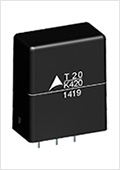source: TDK news
TDK Corporation presents the new T series of EPCOS ThermoFuse™ varistors for intrinsically safe overvoltage protection. These components are based on disk varistors with diameters of 14 mm (T14 series) and 20 mm (T20 series) that are connected in series with a thermally coupled fuse.
ThermoFuse™ varistors
The T14 series (B72214T*) covers the voltage range from 130 VRMS through 420 VRMS. Its surge current capability is 6000 A for a pulse of 8/20 µs in accordance with IEC-61000-4-5, while the permissible power dissipation is 0.6 W. The dimensions are 17 mm x 21.6 mm x 13 mm.
The T20 components are suitable for voltages between 130 VRMS and 1000 VRMS. Their surge current capability is up to 10,000 A (8/20 µs) and their power dissipation is 1.0 W. Depending on the voltage, the dimensions range from 22 mm x 26 mm x 12 mm to 27.5 mm x 27.5 mm x 18.5 mm.
If the varistor of a ThermoFuse overheats, the fuse trips and isolates the varistor from the grid. This prevents fires on the printed circuit board or damage to components located near the varistor. Fuse and varistor are housed together in a plastic enclosure that, like the coating of the varistor, is made from flame-retardant material. The components have three connections: Two for the power cable and one as a monitor output, which enables the display of the status of the component with an LED, for example.
The main applications for ThermoFuse varistors are home appliances, power supplies, photovoltaic inverters, frequency converters, ballasts for lighting systems, surge voltage protectors and electronic meters.
Main applications
Domestic appliances, power supply units, photovoltaic inverters, frequency converters, and ballasts for lighting systems, surge voltage protectors and electronic meters
Main features and benefits
Wide range of voltages from 130 VRMS to 1000 VRMS
High surge current capability of up to 10,000 A
Use of flame-retardant materials






























